Term 1 Chapter 1 | 5th Science - Organ Systems | 5th Science : Term 1 Unit 1 : Organ Systems
Chapter: 5th Science : Term 1 Unit 1 : Organ Systems
Organ Systems
UNIT 1
Organ Systems

Learning Objectives
After completing this
lesson students will be able to:
• know about different
organ systems of human body.
• identify different
organs.
• understand the functions
of different organs.
Introduction
We get energy for our daily activities
from the food we eat. How is the food converted into energy? It is through the
process called digestion. After we eat the food, waste products are removed
from the body. The process involved in this is called excretion. We need oxygen
to survive. Our body gets oxygen through the process, called respiration. These
processes are carried out by different organs in our body. Different organs
form the organ systems. In this lesson we will study about different organ
systems in our body and their functions.
I. Digestive System
The food we eat consists of complex
compounds like carbohydrates, proteins and fats. They have to be converted into
simpler molecules like glucose, amino acids, fatty acids and glycerol
respectively. These simpler molecules are then assimilated either by blood or
lymph in order to give us energy. The process of conversion of complex food
molecules into simpler molecules is called digestion. The digestive system can
be divided into two.
1. Digestive tract
2. Digestive glands
1. Digestive tract (Alimentary canal)
It
is a coiled muscular tube extending from the mouth to the anus. It is about 6-9
metres long and consists of many specialized divisions. Arranged sequentially,
these are: mouth, buccal cavity, pharynx, esophagus, stomach, small intestine,
large intestine, rectum and anus.

Do you know?
There are some organisms which
live in the digestive systems of animals. For example, tape worm lives in the
human intestine.
2. Digestive glands
Three important digestive glands
associated with the process of digestion are:
1.
Salivary glands
2. Pancreas
3. Liver
Salivary glands secrete saliva which
moistens food. Saliva contains enzymes which break down complex starch into
simple cabrohydrate molecules. Pancreas produces pancreatic juice which contains
digestive enzymes for digesting fats, proteins and carbohydrates. Liver
produces bile for the digestion of fat.
Do you know?
The three pairs of
salivary glands parotid, sublingual and submandibular gland secrete
approximately 1.5 litres of saliva every day.
II. Respiratory System
The respiratory system provides oxygen
to the tissues of the body and removes carbon dioxide from the tissues. There
are three major parts forming the respiratory system.
1. Airway
2. Lungs
3. Muscles of respiration
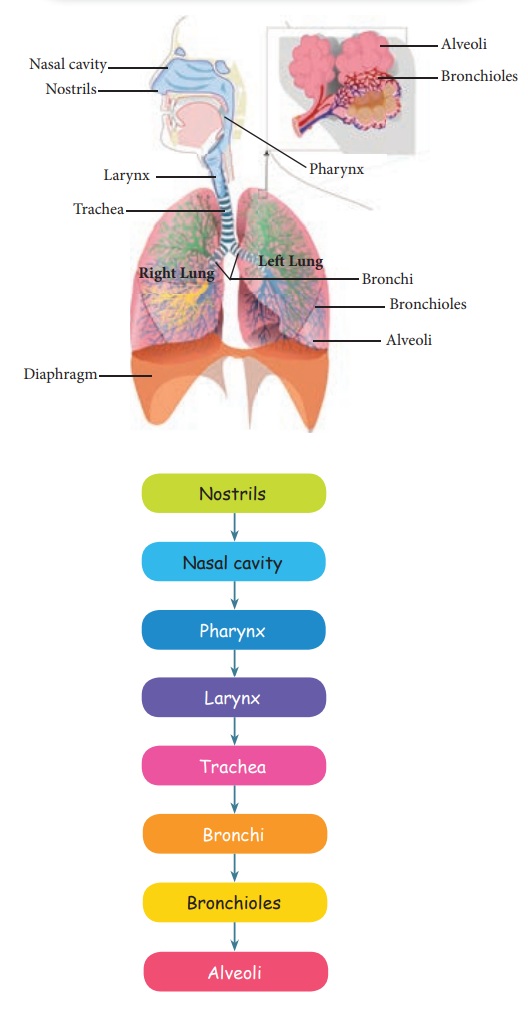
Do you know?
People suffer due to
smoke. Smoke contains large amount of carbon monoxide a toxic gas. People when
engulfed in smoke on fire die due to suffocation.
Activity 1
Sit quietly and count how
many times you breath per minute. On an average, we breath 16-18 times per
minute. Can you guess the number of times you breath in a day? On an average, we
breath more than 20,000 times in a day.
1. Airway
The
airway includes the nasal cavity, pharynx, larynx, trachea, bronchi and lungs. It
carries air between the lungs and the surrounding.
2. The Lungs
The lungs are the primary organs of the
respiratory system. They are paired, cone - shaped organs. They are located
near the backbone on both sides of the heart.
3. Muscles of respiration
Muscles of repiration include disphram
and intercostals muscles. They act as pump and push the air into and out of the
lungs during breathing.
Do you know?
• Air pollution causes
many respiratory diseases.
• Smoking can cause lung cancer.
III. Circulatory System
In this system blood is circulated to
transport oxygen and nutrients to every part of the body. Circulatory system
consists of the following:
1. Heart
2. Blood
3. Blood vessels
1. Heart
The heart is a hollow, muscular organ.
It is somewhat conical in shape. It is covered with double walled membrane called
pericardium. The space between the membranes is filled with pericardial fluid.
The pericardial fluid protects the heart from shock. Heart is placed inside the
thoracic champer (rib cage) in between the two lungs.
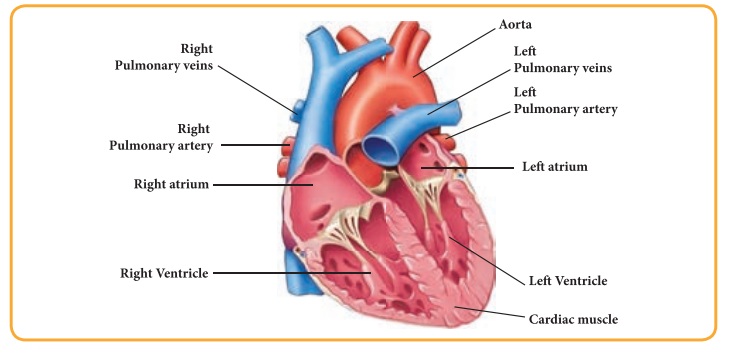
The
heart is divided into four chambers. Two upper chambers are called atria or
auricles (Singular-atrium). Two lower thicker chambers are called ventricles.
The upper and lower chambers of the heart are separated by a muscular wall or
tissue known as the auriculo-ventricular septum of the heart. The right side of
the heart receives deoxygenated blood from various parts of the body and pumps
it to the lungs for oxygenation. The left side of the heart receives oxygenated
blood from the lungs and pumps it into different parts of the body.
2. Blood
Blood
transports nutrients, oxygen, wastes and hormones. The volume of blood in human
adults is 4-5 litres. It regulates water level and the body temperature. Blood
is pumped through out the body by the heart. It takes oxygen to tissues and
cells and finally reaches the lungs to take oxygen again.
3. Blood vessels
Blood
vessels consist of arteries and veins. Arteries carry oxygenated blood (except
pulmonary arteries which carry deoxygenated blood from the heart) and veins
carry deoxygenated
blood (except pulmonary
vein
which carries oxygenated blood to the heart).
Do you know?
There are some animals
like lobsters and crabs that have blue blood. Cockroach has colourless or white
blood.
Activity 2
Locate your pulse points
either on wrist or neck. Place your right index and middle finger on the palm
side of your left wrist. On the neck the pulse point is located beneath the ear
and jaw bone. Count the number of beats for 15 seconds. Multiply this by four
(15 * 4 = 60). This shows how many times the heart beats in one minute.
IV. Excretory System
Excretory system removes the waste
products from the body. It also regulates water and electrolyte balance.
Kidneys, lungs, liver and skin together function as excretory organs. Excretory
system consists of the following.
1. Kidneys
2. Ureters
3. Urinary bladder
1. Kidneys
The kidneys filter the blood to remove
waste and produce urine. The kidneys are a pair of dark red, bean shaped organs
placed behind the abdomen on either side of the vertebral column. The average
adult‛s kidney measures about 12 cm in length, 6 cm in width and 3 cm in
thickness. Right kidney is slightly lower than the left kidney. Each kidney is
covered by a fibrous membrane called capsule.
The kidneys are made up of millions of
excretory units, called Nephrons,
which are the structural and functional units of the kidneys.
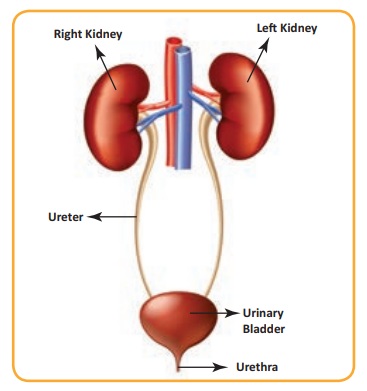
2. Ureters
Two
ureters connect the kidneys with the urinary bladder. Urine formed from each
kidney reaches urinary bladder through ureters.
3. Urinary bladder
It
is sac-like in shape and acts as a temporary storage organ of urine. Urine
entering the urinary bladder from the ureters slowly fill the hallow space
inside the bladder. Urine is expelled from the body through the urethra.
Do you know?
Every minute, kidneys receive
approximately 1.250 litre of blood.
V. Nervous System
Nervous
system is an integration of nerves and specialised cells called Neurons. The
human nervous system is divided into the following.
1.
Central nervous system (CNS)
2.
Peripheral nervous system (PNS)
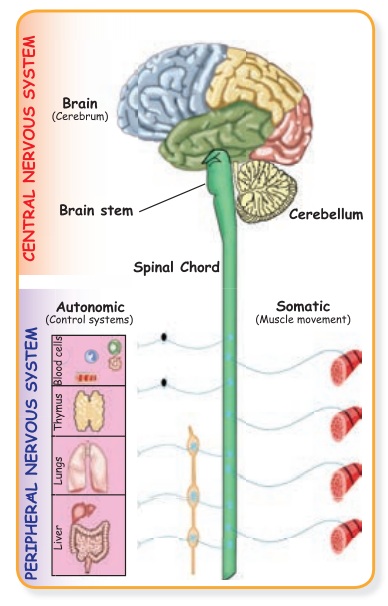
1. Central nervous
system
Central
nervous system consists of the brain, the spinal cord and the nerves.
• Brain
We
use our brain to think, read and write. The brain is covered by three membranes
called meninges. They are dura mater, arachnoid membrane and pia mater. The
brain is kept in a bony case called cranium or skull. It is made up of eight
immovable bones. The brain is made up of millions of functional units called
Neurons.
Human brain is divided into three major
parts.
Fore Brain (Cerebrum)
Mid Brain (Cerebellum)
Hind Brain (Medulla Oblongata)
Fore Brain (Cerebrum)
• The fore brain consists of cerebrum,
thalamus and hypo thalamus.
• It is the largest part of the brain.
• It is the centre of human memory.
• It is responsible for intelligence,
imagination and reasoning.
Mid Brain (Cerebellum)
• It lies behind the cerebrum.
• It co-ordinates the movements of the
muscles of the body.
• It helps to maintain the balance of
the body.
Hind Brain (Medulla Oblongata)
• The hind brain comprises of pons and
medulla oblongata.
• It is also called the brain stem.
• It is called ‘Vital knot‛ because it
controls breathing, heart beat and other involuntary muscles.
• It connects the brain to the spinal
cord.
Do you know?
Average weight of human
brain is 1.300 kg
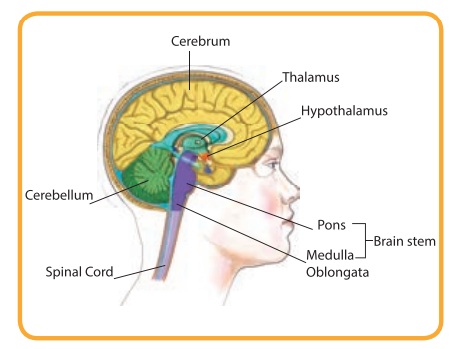
• Spinal cord
Spinal cord is along a tube like
structure which extends from the brain. It lies within the back bone of our
body.
Do you know?
• The Brain needs a
continuous supply of oxygen for better functioning.
• The brain loses the
ability to function when it does not get oxygen for more than 4 minutes.
• Enough sleep and healthy
food increase the efficiency of our brain.
2. Peripheral nervous system
Peripheral nervous system consists of
nerves extending from the spinal cord to all parts of the body. It is made up
of two parts.
• Somatic nervous system
• Autonomous nervous system
Somatic nervous system carries
sensations from the organs to the brain and take messages from the brain to the
organs for movements. Autonomous nervous system controls the nerves of the
inner organs of the body.
Related Topics